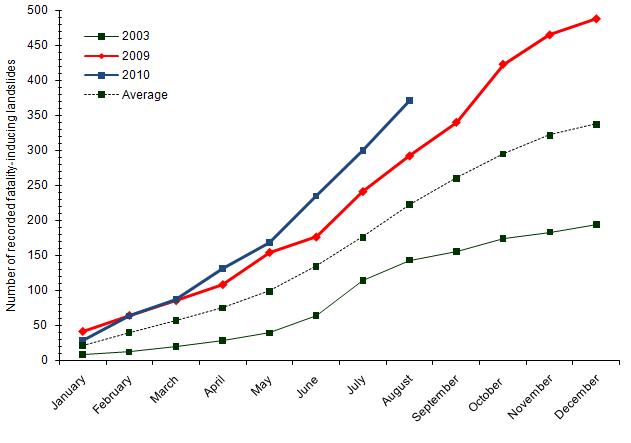3 September 2010
August fatal landslide data
Posted by Dave Petley
The end of the month marks the point at which I post the accumulated totals for fatal landslides, based upon the global fatal landslide database that I maintain. The raw figures for August are stark. The total number of fatal landslides recorded in the month was 71, resulting in 2,740 fatalities. This total is of course dominated by the Zhouqu landslide in China, which is reported to have resulted in 1,765 deaths. (Click on read more to access the remainder of this post).
These totals continue the exceptional trend of landslide occurrence in 2010. The average number of recorded fatality-inducing landslides in August in the period 2002-2009 is 46.7, resulting in an average of 348.3 deaths.
This graph illustrates the magnitude of the anomaly for 2010 to date. This shows the cumulative total number of recorded fatality-inducing landslides for 2003 (which had the lowest total of any year on the database), 2009 (the previous record year), 2010 to the end of August, and the average for 2003-2009. There is no doubt that 2010 is exceptional:
It is interesting that these totals have been recorded in a year that to date has had exceptionally low levels of tropical cyclone activity – indeed Northern Hemisphere tropical cyclone energy release remains at the lowest level for 30 years. When they occur, landfalling NW Pacific tropical cyclones (typhoons) have a major impact upon landslide occurrence. It is notable in particular that the Philippines and the Caribbean islands (especially Haiti) have been spared substantial tropical cyclone events to date this year. Given that there are strong signs that tropical cyclone activity is currently increasing in both the N. Atlantic and the Pacific, the next month will be very interesting.
Of course, the root cause of the exceptional occurrence of recorded landslides in August has been the intensity and volume of rainfall associated with the summer monsoon, primarily in China and Pakistan, and to a lesser extent Nepal. The monsoon should start to weaken during September, but more landslides are likely in the interim given the near-saturated state of the ground.



 Dave Petley is the Vice-Chancellor of the University of Hull in the United Kingdom. His blog provides commentary and analysis of landslide events occurring worldwide, including the landslides themselves, latest research, and conferences and meetings.
Dave Petley is the Vice-Chancellor of the University of Hull in the United Kingdom. His blog provides commentary and analysis of landslide events occurring worldwide, including the landslides themselves, latest research, and conferences and meetings.
Hi Dave,according to this article – http://www.accuweather.com/blogs/news/story/36545/china-flood-landslide-losses-a.aspChina's Ministry of Civil Affairs claims that at least 3,185 lives have been lost in China this rainy season due to landslides and flooding, with a further 1,060 missing. I'm looking for the actual report but not having much luck.
OT, but the http://historyofgeology.blogspot.com/2010/09/2-september-1806-landslide-of-goldau.htmlhas a comprehensive discussion of a landslide in 1806 in the Swiss Alps.Parclair